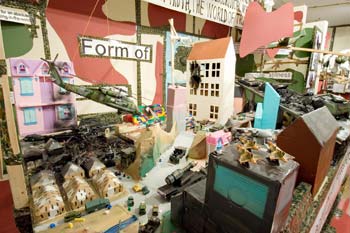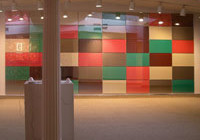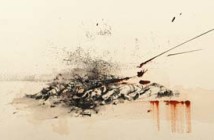Thomas Hirschhorn's "Utopia, Utopia = One World, One War, One Army, One Dress", the latest exhibition at the ICA, looks like an over-stocked department store distastefully promoting camouflage. Simulated displays of commodities surrounded by a decor of "collages" - haphazardly-placed magazine and newspaper images of soldiers, models and citizens sporting camouflaged attire (from sexy briefs to baby clothing) - horrifically reflect what could realistically succeed as a store in today's America, call it "Camouflage City".
Imagine a place where hoards of families could spend an afternoon exercising their favorite pastime in a world of camouflage - T-shirts come in all sizes; helmets shield an unsuspecting blow to the head; a variety of jackets and pants can be mixed and matched; sneakers come in too many styles to choose from; a collection of mutated globes reflect countries
eliminated from the planet; and disfigured mannequins remind the not-too-desensitized of the chemical effects on genocide survivors. Children can re-enact violence, as they have learned it, through dollhouse scenarios with camouflaged baby dolls and multiple forms of Barbie and Ken, dressed in their military best. A portion of each purchase could go directly to the White House to support Bush's "War on Terrorism". By simply buying a camouflaged commodity, one could support killing anyone who disagrees with the policies of the U.S. government. Or, if one is a member of the politically disinterested or the painfully unaware, he can dress in the latest fashion to match his retro seventies
haircut.
Hirschhorn's exhibition bombards the viewer through excessive means. Camouflage imagery and clothing is overabundant, even claustrophobic. Assembled with duck tape and cardboard, it looks more like an assembly of fifth grade social studies assignments than a conceptual exhibit claiming to reflect an essay entitled "worldplay" by Berliner Marcus Steinweg(commissioned by Hirschhorn to write a text for the catalogue). Steinweg's essay may be impressive yet Hirschhorn's work fails to clearly translate concepts from his essay entailing references to philosophers like Nietsche, Deleuze, Foucault and Heidegger.
In relation to these four philosophers, Steinweg makes several points. Nietsche's 'Hyperboreans', strong people who want to take responsibility, "make contact with the real of reality" whereas those from the 'Hypochondriac World' "want to be weak" and "cannot be anything other than victim(s)". Nietsche's 'Uebermensch', "the new human being of the new world", one of "the here and now", is "responsible for itself". In accordance with Hirschhorn's exhibit, does this mean that a self-absorbed fashion conscious female may be able to see herself in the camouflaged images? Should a new male army recruit be able to see through Hirschhorn's camouflage mess and see himself as a victim of a war craze?
Deleuze believes, "There is no subject, but a production of subjectivity" and members of the hyperborean we-collective "are capable of 'trust'; of this belief in themselves, in the world, and in becoming". After seeing the pain and suffering exemplified by Hirschhorn, should the viewer want to relinquish their 'hypochondriac' identities and become part of the 'we collective'?
Foucault believes that "death opens up over and over again the possibility of a renewed beginning". Should one be able to fully accept past crimes committed on humanity and simply move forward with faith and hope when history keeps repeating itself?
Heidigger believes truth is "a result of conflict". Should the viewer accept the barbaric conflicts in this world, no matter what the cost, as a means to understanding truth? When the planet ends, who will be there to reflect that most human beings are unaware that harm done to others is also harm to themselves?
Hirschhorn shows us that the boundaries between war garb and fashion have become erased. Military camouflage, traditionally worn by soldiers to blend into their surroundings, is simultaneously worn by hipsters wanting to blend into the current style, rather than find their individuality. Hirshhorn's
equation "Utopia, Utopia = One World, One War, One Army, One Dress" does not add up. Perhaps it is not supposed to. American mainstream consumers eventually get tired of the latest fashion craze ("One Dress") yet never lose interest in “winning” a war. Sadly, the world will never become "One World" as long as fascist wolves in sheep's clothing (like George Bush) continue committing genocide. The only way there could be "One War" and "One Army" is if this one army turned on itself.
Hirschhorn first assembled the works for this exhibit with his crew in his studio and later shipped them abroad to the ICA. Was it really necessary for the ICA to donate all its space to Hirschhorn's exhibition and invest in such an expense? Does Hirschhorn really address the issues in Steinweg's "Worldplay" or is he simply playing with words? Is Hirschhorn’s act of enlargening Steinweg's text, physically deconstructing it with a pair of scissors, and randomly placing words all over the exhibition supposed to reflect the non-sensical act of war, guerilla marketing, and mass consumption? Is the viewer supposed to leave utterly confused as to why a camouflage jungle is taking up space? Steinweg's philosophical essay addresses worthy concepts yet Hirschhorn's translation comes in fuzzy.
Links:
Institute of Contemporary Art
All quotes taken from exhibition catalog.
Steinweg, Marcus. "WORLDPLAY" in "Thomas Hirschhorn: Utopia, Utopia = One World, One War, One Army, One Dress." Iceland: Oddi Printing, 2005.
copyright 2005 by the authors, the artists; the Institute of Contemporary Art, Boston, MA; and California College of the Arts, San Francisco, CA.
__________________________________________________
"Utopia, Utopia = One World, One War, One Army, One Dress" is on view from September 21, 2005 - January 16, 2006 at the ICA.
All images are courtesy of the ICA Boston.



